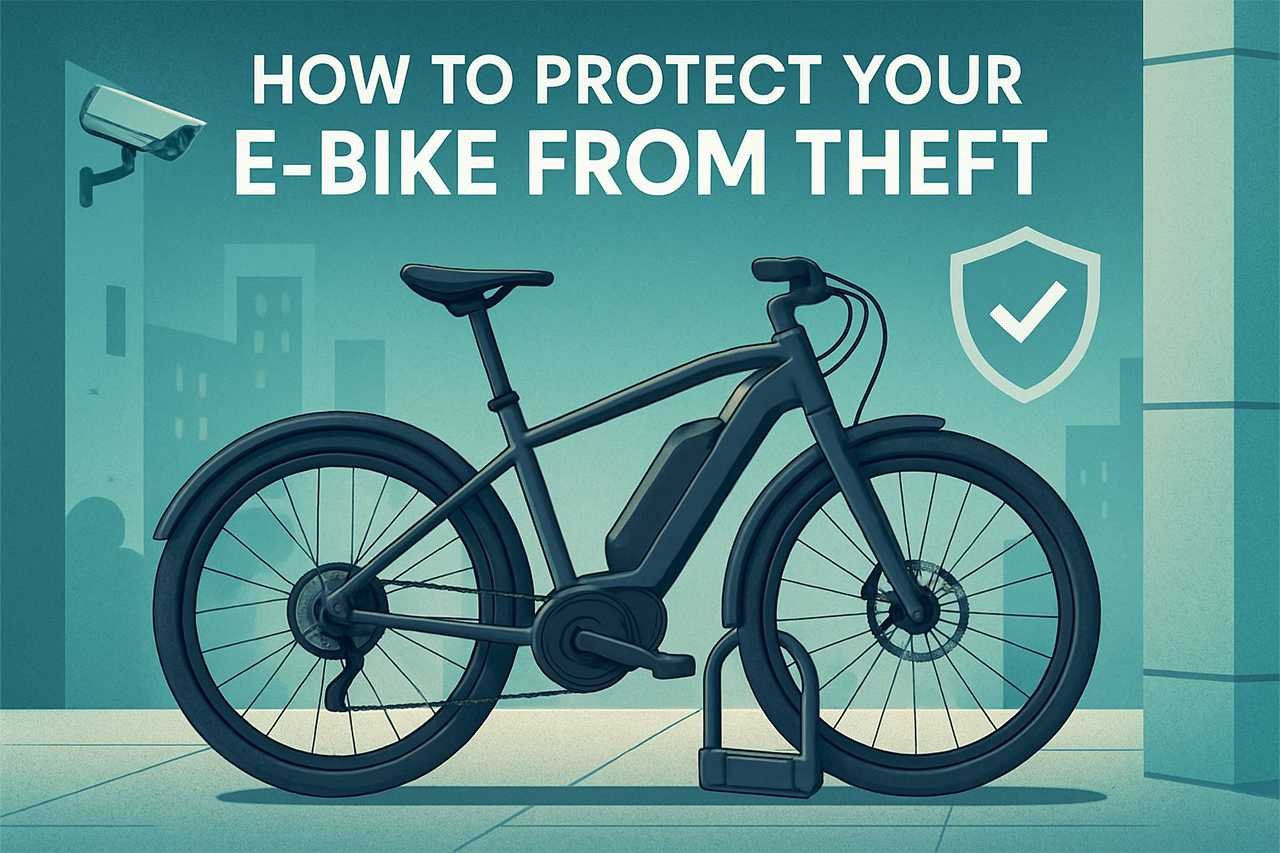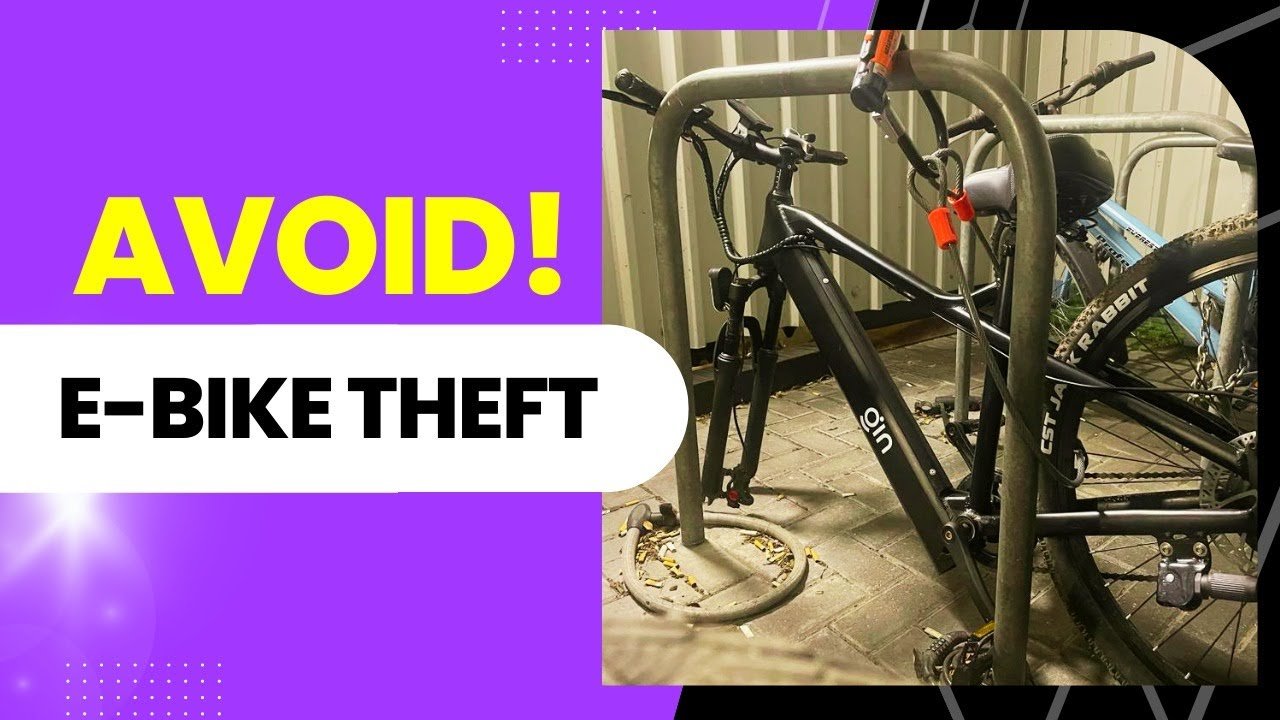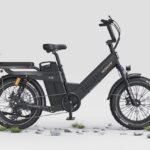
Understanding E-Bike Theft Risks
E-bikes face higher theft rates than regular bicycles due to their premium value and desirable components. Thieves target these bikes using increasingly sophisticated methods and focus on locations where security is weakest.
Why E-Bikes Are Popular Targets
E-bikes cost significantly more than regular bicycles, making them attractive targets for criminals. The average replacement value ranges from £1,473 to £2,500 according to various insurers.
High-Value Components Drive Theft
The battery alone can cost £300-800 to replace. Motors and display units also fetch good prices on illegal markets. These parts are easy to remove and difficult to trace.
Electric bikes hold their resale value better than regular bikes. Bike thieves know that 67% of stolen bikes sell within hours of being taken.
Organized Crime Targets E-Bikes
Professional thieves increasingly focus on electric bikes rather than regular ones. Research shows 78% of bike thefts happen to order, meaning criminals steal specific models for waiting buyers.
Premium e-bike brands like Bosch and Shimano equipped models get targeted most often. Thieves study which models command the highest prices.
Common Tactics Used by Bike Thieves
Modern bike thieves use power tools and sophisticated methods to defeat traditional locks. They work quickly and often in broad daylight to avoid suspicion.
Power Tools Beat Most Locks
Angle grinders cut through most bike locks in under 30 seconds. Thieves also use hydraulic bolt cutters for cable locks and chains. Even heavy-duty U-locks can be defeated with the right tools.
Battery-powered tools make theft silent and fast. Criminals often work in pairs – one acts as lookout while the other cuts the lock.
Targeting Removable Parts
Smart thieves focus on quick-release components when they can’t steal the whole bike. Batteries, wheels, and seats disappear in seconds. Display units and lights also get targeted frequently.
Thieves have become more brazen, even committing muggings for high-value bikes. This trend particularly affects expensive e-bikes in urban areas.
Recognizing High-Risk Locations
Location plays a huge role in e-bike theft risk. Understanding where thieves strike helps riders make smarter parking decisions.
Urban Centers See Most Thefts
Most e-bike thefts happen in public areas in urban centers where bikes are locked to cycle racks. City centers, shopping areas, and transport hubs have the highest theft rates.
Train stations and busy shopping streets attract thieves because of high foot traffic. Criminals blend in easily among crowds of people.
Home Storage Risks
Garden sheds and outbuildings account for many home thefts. Thieves target these areas because they’re often poorly secured and hidden from view.
High-Risk Parking Spots to Avoid:
- Quiet side streets with no foot traffic
- Underground car parks with poor lighting
- Areas without CCTV coverage
- Isolated bike racks away from main paths
- Locations where thieves can work undisturbed
Thieves prefer spots where they can work without being seen or interrupted. They avoid busy, well-lit areas with lots of witnesses.
Choosing the Right Locks for E-Bike Security
Different lock types offer varying levels of protection, weight, and convenience for e-bike owners. U-locks provide maximum security but limited flexibility, while chain locks offer versatility at the cost of added weight, and folding locks balance portability with moderate protection.
U-Locks: The Heavyweight Defender
U-locks represent the gold standard for e-bike security. These hardened steel brackets resist cutting, prying, and drilling attempts better than most alternatives.
The Hiplok D1000 stands out as the top choice with its anti-angle grinder design and Sold Secure Diamond rating. It weighs just over 4 pounds but offers unmatched protection for high-risk areas.
For budget-conscious riders, the Kryptonite New-U KryptoLok Standard provides solid security at $70.95. This model includes a cable for securing the front wheel alongside the main u-lock.
Key U-Lock Features:
- Thickness: 11-20mm hardened steel
- Weight: 2-4 pounds typically
- Security Rating: Gold to Diamond levels
- Price Range: $40-$300
The main limitation of u-locks is their rigid shape. They work best when locking to bike racks or poles that fit within the shackle opening.
Chain Locks and D-Locks: Versatile Protection
Chain locks offer flexibility that u-locks cannot match. Their length allows riders to wrap around larger objects and secure multiple bike components simultaneously.
The Kryptonite Evolution 1090 features 10mm hardened steel links and weighs about 6 pounds. Its patent-pending end link connects directly to the deadbolt, eliminating a common vulnerability.
For those wanting keyless convenience, the Kryptonite Keeper 712 combination chain lock provides 47.3 inches of 7mm manganese steel chain. The combination can be reset as needed for improved security.
D-locks function similarly to u-locks but with a D-shaped design. They offer comparable security with slightly different dimensions and mounting options.
Chain Lock Advantages:
- Length flexibility for various locking scenarios
- Harder for thieves to position cutting tools
- Can secure frame and both wheels together
- Available in combination or keyed versions
Folding Locks Versus Cable Locks
Folding locks represent a compromise between security and portability. The ABUS Bordo Granit 6500 uses 5.5mm hardened steel bars connected by protective rivets.
These locks fold compactly for transport but extend to useful lengths when deployed. They resist sawing attempts better than cable locks while remaining lighter than heavy chains.
Cable locks offer the least security but maximum convenience. They work well as secondary locks for securing wheels or accessories but should never be the primary security method.
Folding vs Cable Comparison:
| Feature | Folding Locks | Cable Locks |
|---|---|---|
| Security Level | Medium | Low |
| Weight | 3-4 lbs | 1-2 lbs |
| Portability | Good | Excellent |
| Price Range | $100-$200 | $15-$50 |
| Best Use | Primary lock | Secondary/accessories |
The Hiplok Gold Wearable Chain offers a unique solution by wrapping around the rider’s waist. This 33.5-inch chain eliminates carrying concerns while providing Sold Secure Gold protection.
Mastering E-Bike Locking Techniques

The best e-bike security comes from securing both the frame and wheels, using multiple locks for layered protection, and positioning locks where thieves can’t easily access them. These three strategies work together to make your e-bike a harder target than others nearby.
Securing Frame and Wheels
Your e-bike’s frame and wheels are the most valuable parts thieves target. A proper locking technique connects both wheels and the frame to a solid anchor point.
The best approach uses a U-lock through the rear wheel, frame, and bike rack. This secures the most expensive components in one move. The rear wheel costs more to replace than the front wheel in most cases.
For the front wheel, thread a cable lock through the wheel and connect it to your main U-lock. This creates a complete security system that protects all major components.
Essential locking points:
- Rear wheel (always secure first)
- Frame (main triangle area)
- Front wheel (via cable extension)
- Removable battery (if applicable)
Quick-release wheels need extra attention. Remove the front wheel and lock it next to the rear wheel when possible. This eliminates the quick-release vulnerability completely.
Using Multiple Locks
Two different lock types create more work for thieves than one expensive lock. Most bike thieves carry tools for one specific lock type, not multiple types.
Combine a U-lock with a chain lock or cable lock. The U-lock handles the frame and rear wheel while the chain secures the front wheel and accessories. This forces thieves to carry different tools and spend more time on your bike.
Different lock types require different cutting tools. A thief with bolt cutters can’t easily cut through a thick U-lock. Someone with an angle grinder might struggle with a hardened chain lock.
The time factor matters most in bike security. Each additional lock adds minutes to the theft attempt. Most thieves abandon bikes that take longer than 3-4 minutes to steal.
Consider these effective combinations:
- U-lock + cable lock (most common)
- U-lock + chain lock (highest security)
- Folding lock + cable lock (portable option)
Optimal Lock Positioning for Maximum Security
Lock placement determines how easily thieves can attack your e-bike lock. Position locks off the ground and away from surfaces that provide leverage for cutting tools.
Keep the lock cylinder facing downward when possible. This prevents dirt and water from getting inside and makes it harder for thieves to access with picks or bump keys.
Fill as much of the U-lock’s interior space as possible. Less empty space means thieves can’t fit cutting tools or jacks inside to break the lock. A tight fit around the frame and wheel works best.
Avoid locking to things that aren’t permanent. Signposts, small trees, and movable objects won’t stop determined thieves. Look for bike racks, thick posts, or sturdy fences instead.
The lock should sit 2-3 feet off the ground when attached. This height prevents thieves from using the ground as leverage for cutting tools. It also keeps the lock away from foot traffic that might damage it.
Smart Parking: Where and How to Park Safely
The right parking spot can make or break your e-bike’s safety game. Smart riders focus on visibility, solid anchor points, and timing to keep their rides secure.
Choosing Well-Lit and High-Traffic Spots
Visibility is your best friend when it comes to deterring bike thieves. Well-lit areas make it nearly impossible for criminals to work undetected on locks and cables.
Parking your electric bike in a public place reduces theft risk significantly. Thieves hate audiences – they need time and privacy to defeat security measures.
High-traffic locations create natural surveillance. Busy sidewalks, popular storefronts, and transit hubs provide constant foot traffic that makes thieves nervous.
Look for these ideal parking characteristics:
- Bright lighting from streetlights or building fixtures
- Steady pedestrian flow throughout the day
- Clear sightlines from nearby businesses or windows
- Security cameras in the immediate area
Avoid dimly lit corners, secluded alleyways, or spots hidden behind dumpsters. These locations give thieves the privacy they need to work on your bike undisturbed.
Securing to Proper Bike Racks
Solid anchor points are crucial for e-bike safety. The strongest lock in the world won’t help if it’s attached to something flimsy that thieves can cut or break.
Concrete-mounted bike racks top the list of secure options. They’re virtually impossible to cut through and can’t be uprooted like lighter fixtures.
Alternative secure anchor points include:
- Thick metal street signs or light poles
- Sturdy handrails bolted to concrete
- Heavy-duty fences (not chain-link)
- Large, mature trees with thick trunks
Avoid these risky anchor points that thieves can easily defeat:
- Parking meters (bikes can be lifted over)
- Thin metal railings
- Chain-link fences
- Wooden posts or structures
Make sure your bike can’t be lifted over whatever you’re locking to. Even the most secure lock becomes useless if someone can simply hoist the entire bike up and over the anchor point.
Avoiding Overnight and Isolated Parking
Time limits matter when it comes to bike security. The longer your e-bike sits unattended, the more opportunity thieves have to work on it.
Try not to leave your electric bike locked up somewhere public overnight. Darkness provides cover, and fewer people around means less chance of interruption.
Isolated parking spots become magnets for theft attempts. Empty parking lots, deserted bike paths, and vacant building areas give criminals the privacy they crave.
Time-based parking tips:
- Daytime parking: 2-4 hours maximum in busy areas
- Evening parking: Under 2 hours with good lighting
- Overnight: Only in secure, monitored facilities
- Weekend parking: Extra caution in business districts
Some cities offer secure indoor parking facilities like cycle hubs or guarded bike parking. These premium options cost more but provide peace of mind for longer-term parking needs.
Research local bike theft hotspots through city forums or cycling groups. Fellow riders often share valuable intel about problem areas to avoid completely.
At-Home E-Bike Security Measures

Storing an e-bike at home requires specific security steps to keep it safe from thieves. The best approach combines secure storage locations with proper indoor positioning.
Garage and Shed Safety
A locked garage offers decent protection, but thieves often target these spaces. Smart e-bike owners add extra security layers beyond just closing the garage door.
Essential garage security steps: • Install motion-sensor lights near the garage entrance • Use a quality bike lock even inside the garage • Position the e-bike away from windows where thieves can spot it • Consider a garage door sensor that alerts when opened
Sheds need similar attention since they’re often less secure than garages. The average shed lock won’t stop a determined thief with basic tools.
Bike owners should anchor their e-bike to something solid inside the shed. A concrete anchor point works well, or they can chain it to heavy equipment.
Using Indoor Bike Storage Solutions
Bringing an e-bike inside eliminates most theft risks. Many people worry about space, but several indoor storage options work well in small areas.
Popular indoor storage methods: • Wall-mounted bike hooks that hold the e-bike vertically • Ceiling pulley systems that lift bikes overhead • Freestanding bike racks for apartments • Bike storage furniture that doubles as decor
The battery should come off and charge indoors regardless of where someone stores their electric bike. This protects the expensive battery and makes the bike less appealing to thieves.
Apartment dwellers often use folding e-bikes that fit in closets or under beds. These models sacrifice some performance but offer unbeatable bike security through easy indoor storage.
Protecting E-Bike Components and Accessories

E-bike components like batteries and wheels are prime targets for thieves due to their high value and easy removal. Securing these parts and removing loose accessories requires specific strategies beyond just locking the frame.
Securing Batteries and Wheels
The battery represents the most expensive component on any e-bike, often costing $500 to $1,000 to replace. Smart riders always remove their battery when parking, even for quick stops at the coffee shop.
Most e-bikes come with removable batteries that simply slide out with a key. This convenience becomes a security feature when used properly. Always take the battery with you or lock it in a secure location.
Quick-release wheels need extra attention:
- Replace quick-release levers with bolt-on axles
- Use a cable lock to secure both wheels to the frame
- Lock the rear wheel with your primary e-bike lock
Some thieves specifically target wheels since they’re easier to steal than entire bikes. A sturdy cable lock threaded through both wheels and the frame creates an effective deterrent.
Removing Loose Accessories
Anything not permanently attached to an e-bike should come with the rider. This includes lights, computers, phone mounts, and bags that can be removed in seconds.
Common accessories thieves target:
- LED lights (especially high-end models)
- Bike computers and GPS devices
- Water bottles and cages
- Saddle bags and panniers
- Phone mounts and charging cables
Securing your accessories becomes second nature with practice. Develop a routine of removing valuable items every time you park.
Even inexpensive accessories add up to significant replacement costs. A basic bike computer, lights, and water bottle can easily total $100 or more.
Quick-release seat posts and saddles deserve special mention. These components can be stolen in under 30 seconds without tools, leaving riders with an expensive repair bill.
Using Technology for Extra Protection

Modern e-bike security goes beyond traditional locks. Smart alarms detect tampering while GPS trackers help recover stolen bikes, and specialized apps provide remote monitoring and control features.
Installing Alarms and Trackers
Built-in alarm systems are becoming standard on premium e-bikes. These systems detect movement or tampering and emit loud sounds to scare off thieves. The noise also alerts nearby people who might help or call authorities.
Some modern e-bikes come with built-in alarm systems that activate automatically when someone touches the bike. Others require manual activation through a key fob or smartphone app.
GPS trackers provide real-time location data when a bike gets stolen. These devices hide inside the frame or attach to hard-to-reach areas. Most GPS trackers send alerts to the owner’s phone when the bike moves unexpectedly.
Popular GPS tracker features:
- Real-time location updates
- Movement alerts
- Geofencing capabilities
- Long battery life (up to 6 months)
- Waterproof design
Leveraging Anti-Theft Apps
Smartphone apps turn e-bikes into smart devices with remote security features. These apps connect to the bike’s built-in systems through Bluetooth or cellular connections.
Anti-theft apps offer GPS tracking, remote locking, and alert notifications when someone tampers with the bike. Users can immobilize their e-bike instantly from anywhere with cell service.
Advanced apps include geofencing features that create virtual boundaries. The app sends alerts when the bike leaves designated safe zones. This helps parents monitor their kids’ riding areas or helps bike shops track test rides.
Key app features to look for:
- Remote engine disable
- Battery level monitoring
- Ride history tracking
- Theft alerts
- Emergency contacts integration
Many apps also store important bike information like serial numbers and photos. This data helps police identify recovered bikes and assists with insurance claims.
E-Bike Insurance and Registration

Getting e-bike insurance and proper registration creates financial protection and legal documentation for your ride. These steps help recover costs if thieves strike and make it easier for police to return stolen bikes.
E-Bike Insurance Options
Most standard bike insurance policies don’t cover e-bikes because of their higher value and electric components. Riders need specialized coverage that understands the unique risks these bikes face.
Homeowners or renters insurance sometimes covers e-bikes, but coverage limits are usually low. Many policies cap bike coverage at $1,000 to $2,000, which won’t replace a quality e-bike.
Specialized e-bike insurance offers the best protection. These policies cover theft, damage, and liability specifically for electric bikes. They understand that e-bikes cost more and need different coverage than regular bicycles.
Here are key coverage types to consider:
• Theft protection – Covers full replacement value if stolen • Damage coverage – Pays for repairs from accidents or vandalism
• Battery protection – Covers expensive battery replacement • Liability coverage – Protects against injury claims involving the e-bike
Premium costs typically range from $200 to $500 annually. The exact amount depends on the bike’s value, where it’s stored, and how often it’s ridden.
Registering Your E-Bike
E-bike registration requirements vary by location, but getting official documentation helps prove ownership. Some areas require registration by law, while others make it optional.
Local DMV offices handle e-bike registration in most areas. Riders bring proof of purchase, identification, and pay a small fee. The process usually takes 15 minutes and costs $10 to $50.
Bike registration databases exist in many cities and counties. These free or low-cost programs create official records that police can access. Registration makes it much easier to recover stolen bikes.
Essential documents for registration include: • Original purchase receipt • Serial number documentation • Photo identification • Proof of residence
Some manufacturers offer their own registration programs. These databases help track stolen bikes and can work with police departments during recovery efforts.
Registration stickers or tags make bikes less appealing to thieves. Visible registration marks signal that the bike is tracked and harder to resell.
What to Do If Your E-Bike Is Stolen

Acting quickly after discovering bike theft can make the difference between recovering your ride and losing it forever. Taking the right steps immediately improves your chances of getting your e-bike back.
Reporting to Authorities
The first step is calling the police to file an official report. Many riders skip this step thinking it won’t help, but it’s crucial for insurance claims and recovery efforts.
When filing the report, provide these details:
- Serial number (usually found on the bottom bracket)
- Make, model, and color of the e-bike
- Exact location and time of the theft
- Photos if available
- Lock type used and how it was defeated
Most police departments now accept online reports for bike theft. This saves time and creates an immediate record. Keep the report number handy – insurance companies require it for claims.
Contact your local bike theft unit if one exists. Many cities have specialized teams that focus on recovering stolen bikes. They often work with local bike shops to identify stolen merchandise.
Increasing Chances of Recovery
Post about the theft on social media immediately. Include clear photos and details about where it was stolen. Local cycling groups on Facebook are particularly effective for spreading the word.
Check online marketplaces daily:
- Craigslist and Facebook Marketplace
- OfferUp and Mercari
- Pawn shop websites
- Bike-specific selling platforms
Given that 67% of stolen bikes are sold within hours, timing matters. Set up alerts for your bike’s make and model on these platforms.
Visit local bike shops and pawn stores with photos. Thieves often try to sell stolen e-bikes quickly at these locations. Shop owners can help watch for your specific bike.
Register your theft with bike recovery services like Bike Index or 529 Garage. These databases help connect stolen bikes with their owners when they’re found.



![How to Change Gears on a Bike: A Beginner’s Step-by-Step Guide [year] How to Change Gears on a Bike: A Beginner’s Step-by-Step Guide [year]](https://goebikelife.com/wp-content/uploads/2023/12/How-to-Change-Gears-on-a-Bike-for-Beginners-768x512.jpg)





